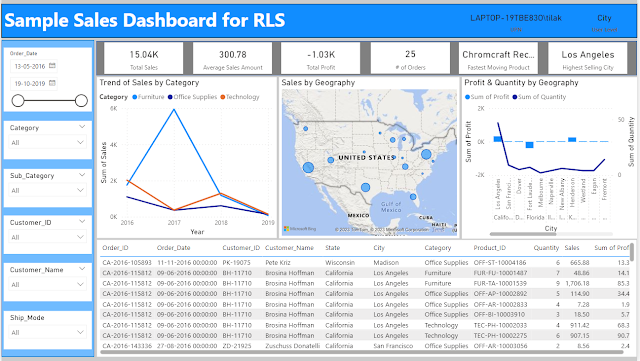Tableau has become one of the leading BI Reporting Tool in past few years. The key selling points are ease of use, attractive look and feel etc. However OBIEE RPD has the upper hand, when it comes to building the Logical Model.
For the projects where OBIEE is already present, what if the business decides to use the better reporting capabilities of Tableau. That means reworking and recreating the logical layer in Tableau.
What if we can combine both of them, and create Tableau reports on top of OBIEE RPD.
To start with, I have the Sample App RPD, and I have created a small subject area 'FOR_TABLEAU'.
Next is to create a ODBC System DSN of type Oracle BI Server 1.
I name it 'TableauOBIEEPOC'. I check 'Clustered DSN' option. Set the Primary Controller as my machine name (full), and the Port as 9706.
Next I give the OBIEE Server Login ID and PW.
Then I select the default Subject Area as 'FOR_TABLEAU'. This step is important and without selecting the default Subject Area, Tableau will not be able to interact properly with OBIEE.
Once done it is time to connect from Tableau. I open my Tableau desktop, and go to Data → New Data Source. In the data source select Other Databases (ODBC).
This will bring up a new window, where we will provide the DSN name and OBIEE Login and Password.
Once authenticated we can Sign In.
Once logged in I can see the Facts and Dimensions I had earlier exposed in 'FOR_TABLEAU' subject area in OBIEE RPD.
For testing purpose let me try to create a simple report. I select Time and Base Facts. In the
join conditions I select any 2 columns from Dimension and Fact, otherwise it will through error. However the main join is going to happen in the RPD.
And I proceed to Sheet 1, and I can see all my fact and dimension columns are visible. Next I create a simple report with T05 Per Name Year and 1-Revenue.
To validate the result I create the same analysis in OBIEE also.
And the results match exactly, which shows our Tableau Analysis is working perfectly with OBIEE RPD.
Before I conclude, I would also like to mention that, there are various other ways of integrating OBIEE with Tableau, like Ritman Mead's 'Unify' to pull your OBIEE reporting data directly into your local Tableau environment.
For the projects where OBIEE is already present, what if the business decides to use the better reporting capabilities of Tableau. That means reworking and recreating the logical layer in Tableau.
What if we can combine both of them, and create Tableau reports on top of OBIEE RPD.
To start with, I have the Sample App RPD, and I have created a small subject area 'FOR_TABLEAU'.
Next is to create a ODBC System DSN of type Oracle BI Server 1.
I name it 'TableauOBIEEPOC'. I check 'Clustered DSN' option. Set the Primary Controller as my machine name (full), and the Port as 9706.
Next I give the OBIEE Server Login ID and PW.
Then I select the default Subject Area as 'FOR_TABLEAU'. This step is important and without selecting the default Subject Area, Tableau will not be able to interact properly with OBIEE.
Once done it is time to connect from Tableau. I open my Tableau desktop, and go to Data → New Data Source. In the data source select Other Databases (ODBC).
This will bring up a new window, where we will provide the DSN name and OBIEE Login and Password.
Once authenticated we can Sign In.
Once logged in I can see the Facts and Dimensions I had earlier exposed in 'FOR_TABLEAU' subject area in OBIEE RPD.
For testing purpose let me try to create a simple report. I select Time and Base Facts. In the
join conditions I select any 2 columns from Dimension and Fact, otherwise it will through error. However the main join is going to happen in the RPD.
And I proceed to Sheet 1, and I can see all my fact and dimension columns are visible. Next I create a simple report with T05 Per Name Year and 1-Revenue.
To validate the result I create the same analysis in OBIEE also.
And the results match exactly, which shows our Tableau Analysis is working perfectly with OBIEE RPD.
Before I conclude, I would also like to mention that, there are various other ways of integrating OBIEE with Tableau, like Ritman Mead's 'Unify' to pull your OBIEE reporting data directly into your local Tableau environment.
















I feel Tableau is a very good and useful visualisation dashboard for solving many complex IT problems.
ReplyDeleteTableau Rest API Connection
yalova eskort
ReplyDeleteantep eskort
sivas eskort
iskenderun eskort
van eskort
antalya eskort
düzce bayan
manisa bayan
izmit bayan
görükle bayan
mmorpg oyunlar
ReplyDeleteinstagram takipçi satin al
Tiktok jeton hilesi
TİKTOK JETON HİLESİ
antalya saç ekimi
referans kimliği nedir
instagram takipçi satın al
metin2 pvp serverlar
ınstagram takipçi satin al
perde modelleri
ReplyDeletenumara onay
Mobil ödeme bozdurma
nft nasıl alınır
ankara evden eve nakliyat
trafik sigortası
Dedektör
web sitesi kurmak
aşk kitapları
smm panel
ReplyDeleteSmm panel
iş ilanları
instagram takipçi satın al
hirdavatciburada.com
WWW.BEYAZESYATEKNİKSERVİSİ.COM.TR
servis
TİKTOK JETON HİLE
en son çıkan perde modelleri
ReplyDeleteözel ambulans
en son çıkan perde modelleri
minecraft premium
nft nasıl alınır
lisans satın al
uc satın al
yurtdışı kargo